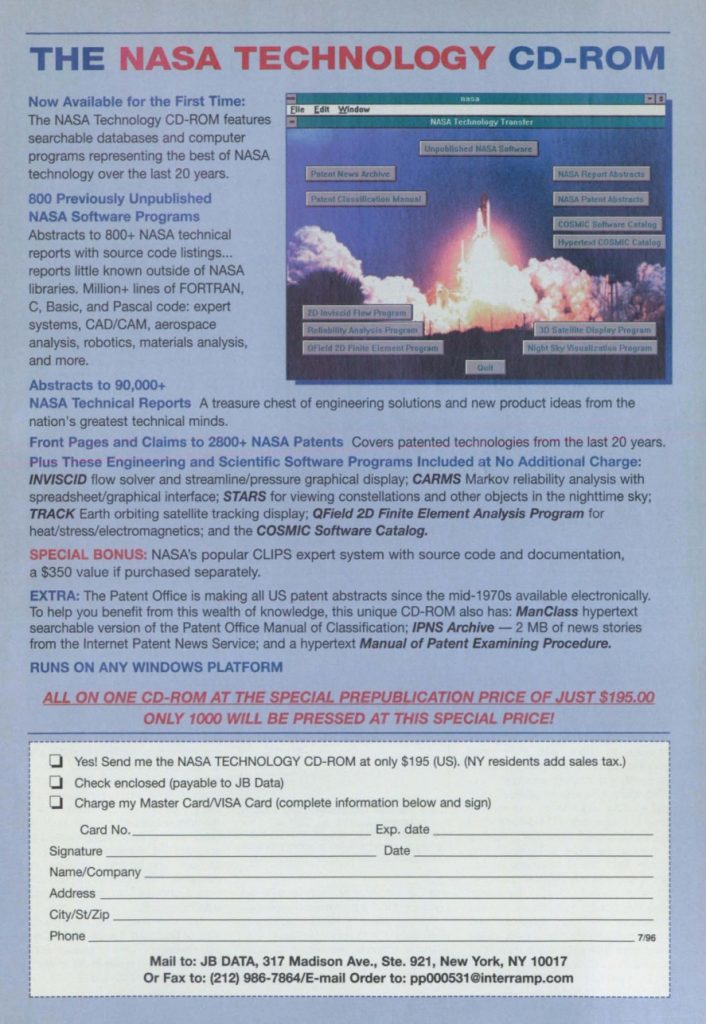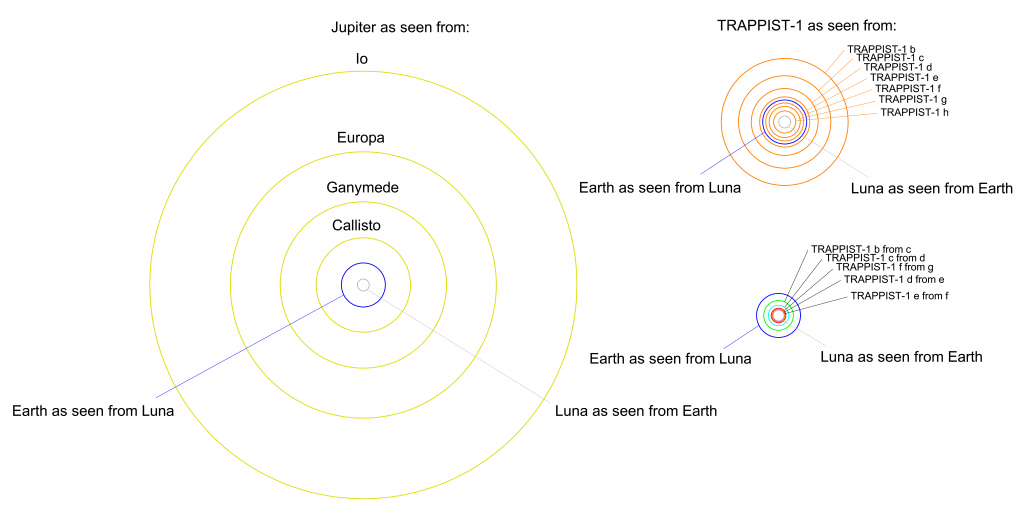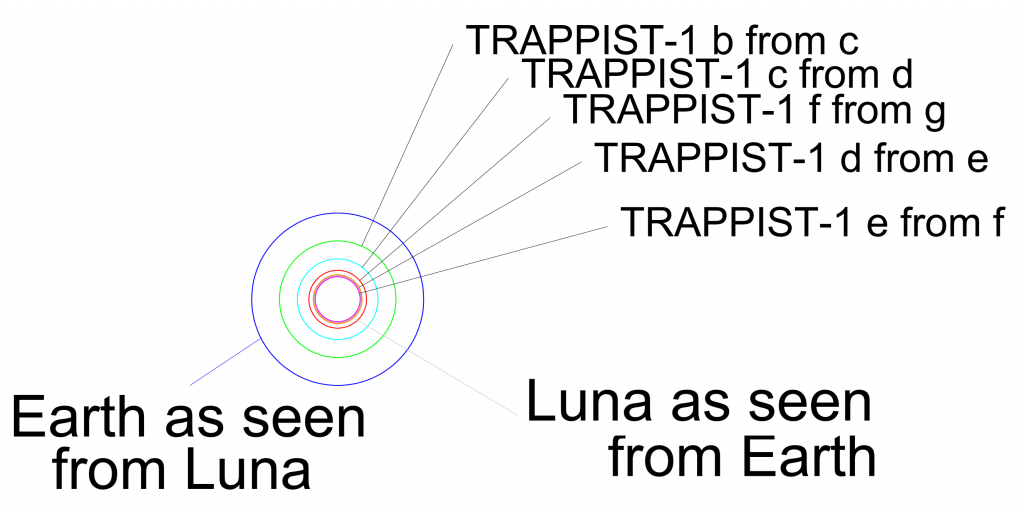An advertisement from a twenty-year-old NASA Tech Brief. It’s selling a single CD-ROM of data… programs, abstracts of reports, patent abstracts. All for the low, low price of $195. Seems kinda steep. Of course, today this could all be downloaded off Ye Olde InterWeb. Heck, I’d be pretty cheesed off about being charged nearly two hundred bucks just for some abstracts.
Hmmm…
SpaceX to Send Privately Crewed Dragon Spacecraft Beyond the Moon Next Year

We are excited to announce that SpaceX has been approached to fly two private citizens on a trip around the moon late next year. They have already paid a significant deposit to do a moon mission. Like the Apollo astronauts before them, these individuals will travel into space carrying the hopes and dreams of all humankind, driven by the universal human spirit of exploration. We expect to conduct health and fitness tests, as well as begin initial training later this year. Other flight teams have also expressed strong interest and we expect more to follow. Additional information will be released about the flight teams, contingent upon their approval and confirmation of the health and fitness test results.
If the Space Race comes back, and it turns out to be an ongoing race between Public and Private *American* programs…. why, that would make me… Hmmm. What’s the word I’m thinking of? It’s a word I don’t use often because I don;t have much use for it. Something like… hoppy? Harppy? Hooppy? Something like that.
However, let’s just say that I’m just a weee tad bit skeptical that SpaceX can go from “we’ve never launched a human nor a Falcon 9 Heavy” to “We used a Falcon 9 Heavy to send humans around the moon” in less that two years. But if they can… hmmm. Happers? Something…
Of course, anyone can chime in.
Here’s the ponderable: it is later in the 21st century. For a few decades, the Catholic population of Europe has been declining, while the overall population has grown substantially. However, the long trend of Europeans becoming less and less religious has reversed; Europeans are now very religious. It’s just not a religion friendly to Catholicism.
So for some years not only have the Catholic churches grown more and more empty, Catholics and the church are coming under increasing attacks, legal and physical. Most Catholic churches around Europe are in fact empty… and mostly empty burned out shells or converted to the replacement religion. So now Catholicism in Europe has contracted to within the walls of the Vatican. And it is clear that very soon it will be physically assaulted and destroyed.
That said, North and South America, Australia and the Pacific island areas remain more or less as they are now, demographically, just more so. There are somewhere in the area of a billion Catholics with a lot of money and resources. It is physically possible to send a flotilla of cargo ships to Italy and load up all the Vaticans stuff and transfer it all elsewhere.
So, the first question: under the immanent threat of destruction, does the Catholic Church pull up stakes and move elsewhere, or does it stay put and put its faith in divine intervention?
Second question: assuming it moves… where to? There are a lot of Catholics in the US and Canada, but a distinct minority of the overall populations. Plus, the idea of setting up a sovereign theocratic nation within US borders is probably not a politically floatable boat. On the other hand… from Mexico on south those lands are *loaded* with Catholics, the vast majority of whom would probably be thrilled to have their home town turned into Vatican 2.
And this being later in the 21st century, the possibility exists of the Catholics setting up Space Vatican, in orbit, on the Moon, Mars, asteroids, wherever. However, getting there would be fabulously expensive, difficult and risky.
My own suspicion is that Mexico and Brazil would be in the lead. But then Argentina seems to have the best climate, and the Caribbean has it’s charms. Cuba, perhaps.
So… any thoughts?
Recently it was announced that the Trump administration has asked NASA to study the possibility of putting crew on the first SLS launch in 2019. If this comes to pass, it will entail sending an Orion capsule around the moon (and back, one would hope), the first time humans have left low Earth orbit in… well, a long-ass time.
What would be the scientific benefit compared the baseline plan of sending the capsule unmanned? Well… not a whole lot, especially given that the mission would be rather rushed. But the political benefits *could* be substantial. Assuming it’s a successful flight, it could be seen and sold as the return of America to having an actual space program (as opposed to the “hey, let’s go in circles a few times in an flying United Nations”). Two American astronauts will go back to the moon; not to land, of course, just to get within spitting distance of it. But almost certainly they will get there before any other nation could pull that off. One can of course argue that the US won the race to the moon in 1969, and anybody going there after all these years is a poor second… but in reality, the US has *long* since lost the direct experience and tribal knowledge that got Apollo tot he moon. Most of the people responsible for making Apollo work are dead or very, very retired. The US going back to the moon would be more like the US going for the first time, just again.
There are two obvious potential downsides to this:
- Disaster. This could come in the obvious form of the crew being killed at any point during the mission. This could also come in the form of the changes in the mission causing so much trouble and delay and cost overruns that the entire launch gets scrapped. Remember, this flight, if it happens, will happen after the 2018 mid-terms. This flight will be Trumps’ baby, and, who knows, he could well be impeached by then.
- How do you follow it up? It’s all well and good to fling some guys past the moon, but this could be done with a substantially smaller and cheaper system than SLS. A pair of Falcon 9 Heavies could certainly do it. The one thing that SLS brings to the party is massive lift capability, which in this case means the ability to send an actual lunar launder. But unless I missed a staff meeting… we have no lunar landers. We don’t even seem to have a real program to develop one.
SLS is meant to launch not only lunar missions but manned missions to Mars. Great! But there are no funded programs to develop actual Mars ships. Lots of people have lots of ideas for what SLS could launch. Some of the ideas are actually pretty good, such as very fast deep space probes, giant space telescopes, components for real space stations, etc. But none of them seem to have the most important feature any such idea needs to have: funding.
The first SLS flight, Exploration Mission 1 (EM-1) is already being assembled. So turning it into a manned flight would entail substantial modificationg to stuff already constructed… never an optimal solution. The second SLS flight, EM-2 scheduled for 2021, is intended to be manned and will have more advanced systems than will be available for EM-1. So it can be readily argued that making EM-1 manned is simply unwise. But the 2021 EM-2 flight would be after the inauguration of whoever wins the Presidential election of 2020. And does Trump – or anybody – really want President Warren to be in charge when NASA next tries to send men to the moon?
So here’s the calculation. NASA does this at Trumps behest, and it crashes and burns: this way leads to DOOOOOOM. NASA does this and succeeds: NASA is golden and Trumps scores points. Launch in 2019 and cement manned deep-space flight into NASAs schedule, or wait until 2021 when there’s a good chance that NASA will be controlled by an Administration that thinks that giant government spending programs are just awesome, so long as they don’t actually *build* anything.
Hmmm.
… but if so, it’s pretty good.
France’s Le Pen cancels meet with Lebanon grand mufti over headscarf
French Presidential candidate Marine Le Pen supposedly had a meeting set up with the Grand Poobah of the Sunni Lebanese, when said glorious leader supposedly demanded that she wear a headscarf, which she refused. Of course there are conflicting accounts… one side said the headscarf was a demand from the get-go, the other that it came after the meeting was set up. In either case, Le Pen’s refusal to put on a scrap of cloth that would actually be occasionally *illegal* back in France will probably hold her in good stead in the forthcoming election.
I figured what the world was lacking was a simple line drawing diagram showing the worlds of the TRAPPIST-1 system to actual scale. The worlds are to scale in both diameter and orbital radii.
Considering some additions. The main one: comparison of how big the primaries are in the skies of the secondaries. Suggestions?
Note: TRAPPIST-1 is the headlining image on Google today. It’s actually pretty cute.

UPDATE:
Here’s what things look like from other things. On the far left is how Jupiter looks in the sky of the four Galilean moons, compared to how Luna looks from Earth and Earth looks from Luna. One the top right is how the TRAPPIST-1 star looks from its various planets. Note that even though the star is *dinky,* it is gigantic in the sky of its planets due to proximity. For all of them, the star is bigger than the moon as seen from Earth (and thus bigger than Sol in Earths sky).
At lower left is how some of the planets look from some of the other planets at closest approach. Note that virtually all closest approaches are *substantially* bigger in the sky than the moon in Earths sky, though none are as big as the Earth in Lunas sky.
Note that all three of these views are to the same scale. Jupiter from Io would be an amazing and quickly fatal sight.
Here’s just the planet-to-planet view:
I have some small hope that anybody reading the title of this post won’t actually believe that I believe it. I would hope that *nobody* would believe the title. But as with so many of my hopes, this is another one that has been dashed. For there are people – not just uneducated jerkwater morons, but educated university professors such as Georgetown University’s Jonathan Brown – who believe that slavery, when done under the rules of one particular religion, is a wonderful thing. And that rape doesn’t exist because it was never mentioned in his favorite book of religious fairy tales.
Professor Uses Lecture to Defend Islamic Slavery
The lecture was sufficiently vile that even fellow Muslims were appalled.
It seems Prof Brown is a recent convert. There’s no fanaticism like that of the recently converted… the newly minted vegan or non-smoker or non-drinker or… but to get *really* nasty, nothing beats the new convert to a religion. Especially when you think that your new religion not only puts you right with some divine moral absolute, but also gives you the right to be a monumental dick.
Of course, this lecture has received some discussion and debate in the days since it was publicized. And of course Prof Brown is trying to walk it back, with the usual “I was taken out of context” scheme we always see when someone is recorded saying something indefensible.Brown even starts out his lecture by announcing that he will be saying hyperbolic things and that he’ll be taken out of context.
It was clear that he wanted to make sure that he controlled the debate as he had a “Jihad Watch” reporter expelled prior to his lecture. But what’s extra-remarkable is that the audio of the lecture was uploaded to YouTube by… prof Brown his own self. Clearly he thought that his advocacy and defense of the indefensible was perfectly wonderful.
Here’s a simple test: if you are being a dick and your understanding of your deity backs you up on your dickishness… consider that perhaps either your deity is a dick and does not deserve your worship and belief, or that you are simply a dick and have chosen a belief system to confirm your dickish nonsense.
Here’s a shorter video of the lecture. Better audio, though edited.
I mean, other than anybody…
Soda companies, supermarkets report 30-50 pct. sales drop from soda tax
Short from: Philadelphia institutes a high tax on sugary drinks. The end result is that people have stopped buying them… or at least, stopped buying them in city limits. And the end result of *that* is:
One of the city’s largest distributors says it will cut 20 percent of its workforce in March, and an owner of six ShopRite stores in Philadelphia says he expects to shed 300 workers this spring.
Good job.
The funniest part of the story is this panicky email from the Mayor:
I didn’t think it was possible for the soda industry to be any greedier … They are so committed to stopping this tax from spreading to other cities, that they are not only passing the tax they should be paying onto their customer, they are actually willing to threaten working men and women’s jobs rather than marginally reduce their seven figure bonuses.
Huh. You raise a tax on a product, and the people selling the product don’t cut the price of the product so that the customer pays the same? How scandalous!
The real question in situations like this is: are the people who push for this sort of thing, then act surprised when the inevitable happens, stupid, deluded or just lying? When you tax something, you get less of it. When you subsidize something, you get more of it. This not only just makes sense, it’s also historically supported.
Extra betterness: the city is relying on the soda tax to fund its schools. They had planned on $7.6 million per month in tax revenues for that purpose, but only drew in $2.3 million the first month. So, once again good job: linking childhood education to a tax scheme that you had to know would be a disastrous failure.
Even more betterocity: the results of this have meant that far less soda is sold in town, which means far less soda needs to be moved into town via truck, which means there’s less work for truckers, which means members of the Teamsters Union are seeing up to 70% pay cuts. Good job, Democrats who supported this: you’re ticking off the Teamsters.
For some fun reading, take a look at the Wikipedia page of Philadelphia Mayor Jim Kenney. Right after the section on the sugary drink tax he pushed is a section on his opposition to Donald Trump… with extra emphasis on how he’s going to maintain Philadelphia’s status as a crime-enabling “sanctuary city.” Yeah. I’m sure that’ll work out greeeeeaaaat.










